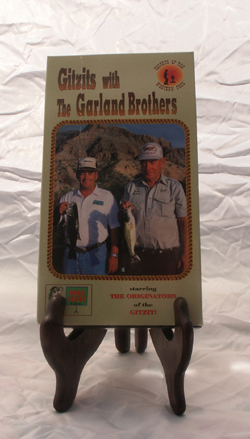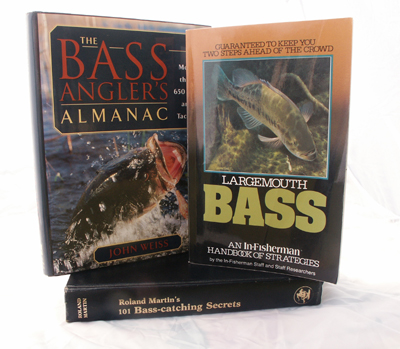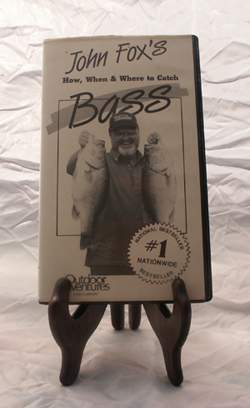The Gitzit!

Field and Stream’s April 2006 featured article, 50 Best Lures of All Time, lists the tube bait or Gitzit in the number 9 spot. The number 1 spot (drum roll, please) is the Gitzit’s first cousin, the Curly Tail Grub. Whether you agree with John Merwin’s placement has much to do with whether or not you have spent some real quality time with a Gitzit. Second place went to the Dardevle spoon, an all-around lure that attracts the full gamut of sport fish. Change the title to “50 Best Bass Fishing Lures of All Time,” and the Gitzit would more than likely be awarded the first or second spot.
Produced by Bazz Clazz Videos, Gitzits with the Garland Brothers is one of the best bass catching videos of the past 20 years. From the perspective of a retired high school English teacher and a devotee of Gitzits fishing for small mouth and large mouth bass in the Sacramento Delta, I would place this video somewhere in the top five positions of videos that actually teach, and where the results can be replicated by amateurs. Pro fisherman Dan Warme, an expert in his own right, carefully mines all the great tube bait fishing techniques from the inventors of the Gitzit, Bobby Garland and his brother Gary Garland.
The tube bait is just that. It is a slender, hollow, rubber tube in which the last 40% of the tube’s length is split or cut into tentacles. Hook size and weight is determined by the size of the tube bait, the depth to be fished and the time of descent as the tube spirals to the bottom. Probably the most common weight is a 1/16 or 1/8 oz. weight. Lead-head jig hooks are inserted through the top of the tube, exiting out the bottom. They may be rigged Texas style or they may be used with a weedless jigging hook or with a split-shot rigging. The Gitzit does it all. Add foam and it floats. Pull the lead-head back to create a pocket of air and it slowly spirals down to suspended fish. Best of all, when it comes to rest on the bottom, the tail stands up straight allowing the tentacles to breathe naturally with a rhythmic pulse, making it easier for a bass to locate and pick up in a soft, mucky bottom.
(photo 3)
Although I am comfortable with a bait-casting reel or a spinning reel in my hands, I never lose an opportunity to fish with my fly rod. I began my formative years as an angler fishing independently with my father’s fly rod in second grade in Bishop, California. Garden hackle, salmon eggs, crickets and hoppers were the bait of choice for trout and later blue gill in southern California during the fifties, the golden years. Had someone handed me a Gitzit, I would have been a passionate devotee for the rest of my life. Returning to California for the last four years of my teaching career, I stumbled upon Gary Garland’s tube baits (www.canyon-plastics.com) and had smashing success fishing for small mouth bass in the slows rivers surrounding Modesto. Some of the largest bass that I have caught was during the spawn fishing the smaller Gitzits on slow-moving rivers that dump into the San Joaquin River, a major tributary feeding the Sacramento River. If you are new to bass fishing, I highly recommend the video, “Gitzits with the Garland Brothers.” Take some along on your next bass fishing trip, and print up the Tips Sheet below. Since it is condensed information, cut and paste and then print and tape to a Gitzit box. If you really want to learn, take notes and chart your success.
Dave Archer
Dave’s Gitzit Tips from the Video and his Own Experience (Print, cut and paste on your Gitzit box.)
1. Always keep the Gitzit rigged straight.
2. Use a weedless lead-head hook for fishing the bottom and structure.
3. Fishing the fall: Use 1/16 oz. hooks or create an air pocket up front.
4. For pitching rig the Gitzit Texas style with a sliding bullet head sinker.
5. Fish the Gitzit with a split shot 18-inches up from the Gitzit to keep the Gitzit
floating up off the bottom.
6. Always watch the line for movement and soft takes.
7. Always cast over your target. Slowly reel back to the target and allow the
Gitzit to free-fall vertically to the bass or target. On a slow moving river,
cast upstream so the Gitzit free-falls to the target zone.
8. For best results, use a spinning reel with 8 to 10-pound line. Allow some
measure of drag for the take, but not too much to miss the hook set.
9. Fish white Gitzits for bass feeding on shad in open water, and paint on eyes if
you bury the lead-head for slower retrieves and minnow action.
10. For deep water retrieves, allow the Gitzit to sink on a set count. Reel five or
six time somewhat fast, pause and then give a SLIGHT twitch upwards. Repeat.
11. Use a skip cast to reach hard targets under trees and docks.
12. Color Selection:
Dark brown or pumpkin with flakes = crawfish imitations early in the morning
Smoke with Silver or translucence with flakes = mid morning, clear water
Cloudy day = electric grape
Pearl white = shad imitation
Chartreuse and green = sun fish
13. Fish the fall or the crawl! If you rig the lead-head outside the tube, you can cut
off part of the lead to slow the fall to spooky bass in shallow water.
14. Size counts! Size down for non- feeding fish or spooky fish and size up during
the bite.
15. Fish the Gitzit year-around.

